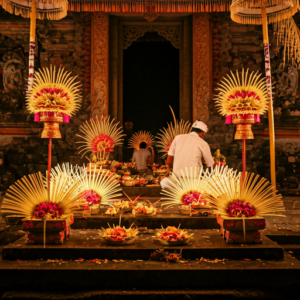
Balinese woodcarving is a distinguished art form that has captivated the world with its intricate details, cultural significance, and aesthetic beauty. This craft, deeply rooted in Bali’s history and culture, represents more than just artistic expression; it is a testament to the island’s rich heritage and the exceptional skill of its artisans. Exploring Balinese woodcarving offers a glimpse into the island’s artistic traditions, spiritual beliefs, and the painstaking craftsmanship that transforms simple timber into stunning works of art.
The History of Balinese Woodcarving
Woodcarving in Bali has a long and storied history, dating back to ancient times when the craft was primarily used for religious and ceremonial purposes. The art form flourished under the influence of Hinduism and Buddhism, which were introduced to Bali through cultural exchanges with India and China.
- Hindu-Buddhist Influence: The arrival of Hinduism and Buddhism in Bali brought new artistic and spiritual dimensions to the island. Temples and royal palaces were adorned with intricate woodcarvings depicting deities, mythical creatures, and scenes from religious texts like the Ramayana and Mahabharata. These carvings served both decorative and devotional purposes, enhancing the spiritual atmosphere of sacred spaces.
- Royal Patronage: Balinese woodcarving received significant patronage from the island’s royal families, who commissioned elaborate works to embellish their palaces and temples. This support helped elevate the craft to new heights, with artisans developing increasingly sophisticated techniques and styles.
- Colonial and Modern Periods: During the Dutch colonial period and subsequent years, Balinese woodcarving continued to evolve, incorporating new influences and expanding its reach. The rise of tourism in the 20th century brought international recognition to Balinese woodcarving, leading to greater demand for these artworks and providing new economic opportunities for local artisans.
Techniques and Materials
Balinese woodcarving is characterized by its meticulous craftsmanship, detailed designs, and the use of high-quality materials. The process involves several stages, from selecting the right timber to the final finishing touches.
- Selection of Timber: The choice of wood is crucial in Balinese woodcarving. Teak, mahogany, and ebony are among the most commonly used woods due to their durability, fine grain, and ability to hold intricate details. Jackfruit wood is also popular for its golden hue and smooth texture, making it ideal for detailed carvings.
- Design and Sketching: Before carving begins, the artisan sketches the design on the wood, often using traditional motifs and patterns. These designs can range from simple geometric shapes to complex scenes featuring deities, animals, and floral elements.
- Carving Process: The actual carving is done using a variety of tools, including chisels, knives, and mallets. The process is highly detailed and time-consuming, requiring great skill and precision. Artisans work carefully to bring the design to life, starting with the rough outlines and gradually adding finer details.
- Finishing Touches: Once the carving is complete, the piece is sanded and polished to achieve a smooth finish. Depending on the intended look, the wood may be stained, painted, or left in its natural state. In some cases, gold leaf or other embellishments are added to enhance the visual appeal.
Styles and Motifs
Balinese woodcarving encompasses a wide range of styles and motifs, each with its own unique characteristics and symbolic meanings. These styles often reflect the island’s cultural and religious diversity, as well as the personal creativity of the artisans.
- Traditional Religious Carvings: Many Balinese woodcarvings are inspired by religious themes, depicting scenes from Hindu mythology, Buddhist teachings, and local folklore. Common motifs include gods and goddesses, demons, and mythical creatures like the barong (a lion-like creature symbolizing good) and rangda (a demon queen representing evil).
- Floral and Fauna Motifs: Natural elements such as flowers, leaves, and animals are also prevalent in Balinese woodcarving. These motifs are often used to symbolize various aspects of life and nature, reflecting the island’s lush landscapes and biodiversity.
- Abstract and Modern Designs: While traditional motifs remain popular, contemporary Balinese woodcarvers also experiment with abstract and modern designs. These pieces may incorporate geometric patterns, stylized forms, and innovative compositions, showcasing the versatility and creativity of Balinese artisans.
Cultural Significance
Balinese woodcarving is more than just an art form; it is deeply intertwined with the island’s cultural and spiritual identity. The carvings often serve specific purposes and hold significant meanings within the context of Balinese society.
- Religious Functions: Many woodcarvings are created for religious use, adorning temples, shrines, and other sacred spaces. These carvings help to convey spiritual teachings, inspire devotion, and create a sanctified atmosphere for worship and ceremonies.
- Symbolism and Mythology: The motifs and symbols used in Balinese woodcarving often have profound symbolic meanings. For example, the barong represents protection and benevolence, while the lotus flower symbolizes purity and enlightenment. These symbols help to communicate important cultural values and beliefs.
- Community and Identity: Woodcarving is a communal activity in many Balinese villages, with knowledge and skills passed down through generations. The craft fosters a sense of community and continuity, preserving cultural traditions and reinforcing local identity.
Notable Carving Centers
Several villages in Bali are renowned for their woodcarving traditions, each with its own distinctive style and specialties. Visiting these carving centers offers a deeper appreciation of the craft and an opportunity to see artisans at work.
- Mas Village: Located near Ubud, Mas Village is famous for its high-quality woodcarvings, particularly those depicting religious and mythological themes. The village is home to many master carvers who create intricate and expressive works, ranging from small sculptures to large, elaborate pieces.
- Tegalalang Village: Known for its scenic rice terraces, Tegalalang is also a hub for woodcarving. The village specializes in decorative items and souvenirs, such as masks, wall panels, and furniture. Visitors can explore numerous workshops and galleries showcasing a wide variety of carvings.
- Kemenuh Village: Kemenuh is another important center for Balinese woodcarving, with a focus on both traditional and contemporary styles. The village hosts several art studios and cooperative workshops where visitors can observe the carving process and purchase unique pieces directly from the artisans.
The Future of Balinese Woodcarving
Despite the challenges posed by modernization and globalization, Balinese woodcarving continues to thrive, thanks to the dedication of its artisans and the growing appreciation for traditional crafts.
- Preservation of Tradition: Efforts are being made to preserve traditional woodcarving techniques and motifs through education and training programs. These initiatives help to ensure that the knowledge and skills of master carvers are passed on to younger generations.
- Innovation and Adaptation: Balinese woodcarvers are also embracing innovation, experimenting with new designs, materials, and techniques. This adaptability allows the craft to remain relevant and appealing to contemporary audiences while retaining its traditional roots.
- Global Market: The global demand for authentic, handcrafted goods provides economic opportunities for Balinese woodcarvers. Many artisans now sell their work internationally, both through online platforms and at art fairs and exhibitions. This exposure not only supports the local economy but also raises awareness of Balinese culture and craftsmanship.
Conclusion
Balinese woodcarving is a remarkable expression of the island’s artistic heritage, reflecting the skill, creativity, and spiritual depth of its artisans. From religious icons and mythological scenes to decorative motifs and contemporary designs, Balinese woodcarvings captivate the imagination and convey the rich cultural traditions of the island. As the craft continues to evolve and adapt to changing times, it remains a vital and cherished aspect of Balinese identity, offering a timeless connection to the island’s past and an enduring legacy for future generations. Exploring the world of Balinese woodcarving is a journey into the heart of Bali’s artistic soul, where every piece of timber tells a story of devotion, beauty, and craftsmanship.





